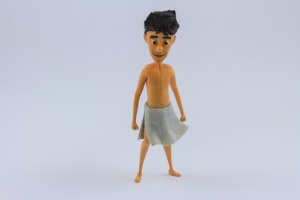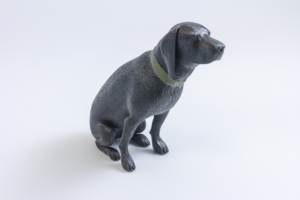Fall in love with a rainbow of 3D printable colors this Valentine’s Day, as online 3D printing service i.materialise enhances its full-color 3D printing options with the launch of its new and improved Multicolor+ material, currently in beta trial.
i.materialise’s advanced Multicolor+ will replace ColorJet technology, and as you can see from the image of the rainbow-colored letters to the left, is definitely brighter than the old Multicolor. The company, which has extensive knowledge of 3D printing materials and colors, is the first to make this new full-color 3D printing option fully available to everyone.
According to i.materialise, “Models made in Multicolor+ are made with a UV Inkjet printer to produce full color strong parts that are as equally good as injection molded parts. 3D printed Multicolor+ has a layered buildup which is visible when looking closely.”
Multicolor+ technology combines 2D and 3D printing, using UV-curable inks. It was developed by 2D color and inkjet technology leader Mimaki Japan as color 3D printing comes further into focus; Mimaki USA recently installed its first full-color 3DUJ-553 3D printer, capable of printing in over 10 million colors, in the Americas. The technology introduces a myriad of full-color projects and possibilities for consumers, and is perfect for 3D printing full-color objects such as avatars, figurines, and architectural models.
“Full-color 3D printing is at the core of i.materialise and introducing the new Multicolor+ gives us the possibility to go a step further in this direction,” i.materialise Director Miranda Bastijns told 3DPrint.com.
“With the new technology by Mimaki, we can give access to professional quality color 3D printing without barriers to creativity and durability.”
- Happy Valentine’s Day!
- …also Happy Valentine’s Day?
If you’re curious what sets Multicolor+ apart from Multicolor, buckle your seat belt – the innovative material technology offers so much more than full-color 3D prints, though that is a very important quality.
First off, Multicolor+ is stronger than its predecessor, using a sturdier plastic as opposed to plaster. The colors are also brighter, making your 3D printed models more intense and vivid.
3D prints made using Multicolor+ technology have an improved surface quality, offering less visible layers and an altogether smoother surface. You can also expect detailed designs to come out with much higher precision, which allows for a rich color reproduction, and it has a high water resistance as well.
 Multicolor+ also makes it possible to design thinner walls for intricate designs. The minimum wall thickness is 1 mm, but i.materialise suggests a thickness of at least 1.5 mm for larger sections. It’s also possible to design and 3D print interlocking parts with Multicolor+, though it’s necessary to remember that important spacing between the surfaces, as this will determine how bendable your design is.
Multicolor+ also makes it possible to design thinner walls for intricate designs. The minimum wall thickness is 1 mm, but i.materialise suggests a thickness of at least 1.5 mm for larger sections. It’s also possible to design and 3D print interlocking parts with Multicolor+, though it’s necessary to remember that important spacing between the surfaces, as this will determine how bendable your design is.
“We recommend keeping a minimum space of 0.5 mm between surfaces,” Aura Farrando writes in an i.materialise blog post. “The more space you leave, the easier it will be to remove support material.”
If you’re interested in using Multicolor+ to make assembled parts, you can avoid friction by leaving at least 0.6 mm between them.
Additional design guidelines for Multicolor+:
- The maximum size for Multicolor+ 3D prints is 150 x 150 x 150 mm.
- To obtain textured models, make sure the proper texture information is included by double-checking the preview on the order page.
- Letters for engraved text or surface details should have a minimum line thickness and depth of 0.5 mm each. Line thickness and height of at least 0.5 mm is also advised for embossed text and surface details.
- Maintain a wall thickness of at least 1.5 mm when hollowing out your models, so the support material doesn’t get trapped; any thinner, and you’ll need to add at least two escape holes with a 10 mm diameter.
Discuss this and other 3D printing topics at 3DPrintBoard.com or share your thoughts below.
[Images provided by i.materialise]
Subscribe to Our Email Newsletter
Stay up-to-date on all the latest news from the 3D printing industry and receive information and offers from third party vendors.
You May Also Like
Precision at the Microscale: UK Researchers Advance Medical Devices with BMF’s 3D Printing Tech
University of Nottingham researchers are using Boston Micro Fabrication‘s (BMF) 3D printing technology to develop medical devices that improve compatibility with human tissue. Funded by a UK grant, this project...
3D Printing Webinar and Event Roundup: April 21, 2024
It’s another busy week of webinars and events, starting with Hannover Messe in Germany and continuing with Metalcasting Congress, Chinaplas, TechBlick’s Innovation Festival, and more. Stratasys continues its advanced training...
3D Printing Webinar and Event Roundup: March 17, 2024
It’s another busy week of webinars and events, including SALMED 2024 and AM Forum in Berlin. Stratasys continues its in-person training and is offering two webinars, ASTM is holding a...
3D Printed Micro Antenna is 15% Smaller and 6X Lighter
Horizon Microtechnologies has achieved success in creating a high-frequency D-Band horn antenna through micro 3D printing. However, this achievement did not rely solely on 3D printing; it involved a combination...




































